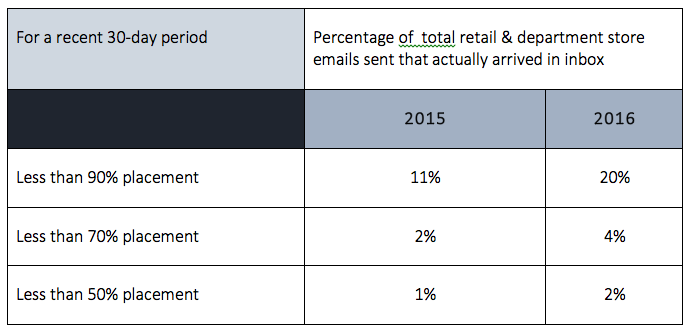'
Deliverability is trending downward – what now??
By John Landsman, Director of Strategy and Analytics
Armed with insights by tracking emails from 90,000 brands daily – not to mention our own experience as marketers and analysts – we’ve identified several key strategies that will help you improve your open and clickthrough rates. The following is the first quick study in our “Getting Smart with Email Marketing” series.
Even the most creative and competitive campaigns drive absolutely no revenue when they can’t be opened because they didn’t make it to the inbox.
For every 1% loss in inbox placement, $150,000 is lost on a list of 10 million subscribers with an annual value of just $1.50 each.
Deliverability is deteriorating significantly, and at an alarming rate just in the past twelve months.

Why is this? The root of most loss in inbox performance: best practice lapses.
Sloppy opt-in procedures.
Assure positive, active opt-in of every new subscriber’s address, and give them something in return for their trust and interest.
Assure positive, active opt-in of every new subscriber’s address, and give them something in return for their trust and interest.
Poor list maintenance and hygiene.
Regularly scrub your list for email address quality and changes, removing invalid, non-responsive and duplicate addresses.
Regularly scrub your list for email address quality and changes, removing invalid, non-responsive and duplicate addresses.
Continuing to mail inactives.
Review your list for addresses that need resting, re-activating or re-opting in.
Review your list for addresses that need resting, re-activating or re-opting in.
Routinely sending irrelevant mail.
Target email based on customer status, preference and behavior.
Target email based on customer status, preference and behavior.
No knowledge of how your IPs are doing.
Understand which IPs are performing the best, especially if you’re using an email marketing vendor on shared IP addresses.
Not tracking major ISPs for inbox placement.
Gmail, Yahoo, Outlook and AOL represent the majority of email volume, so at least track them.
Using seed data alone to monitor deliverability.
Tracking actual inboxes is more accurate than monitoring fake accounts.
Unaware of blacklist changes to your IP or domain.
Sign up for automated blacklist alerts to get real-time notifications.
Try turning these things around to stop leaving money on the table.








